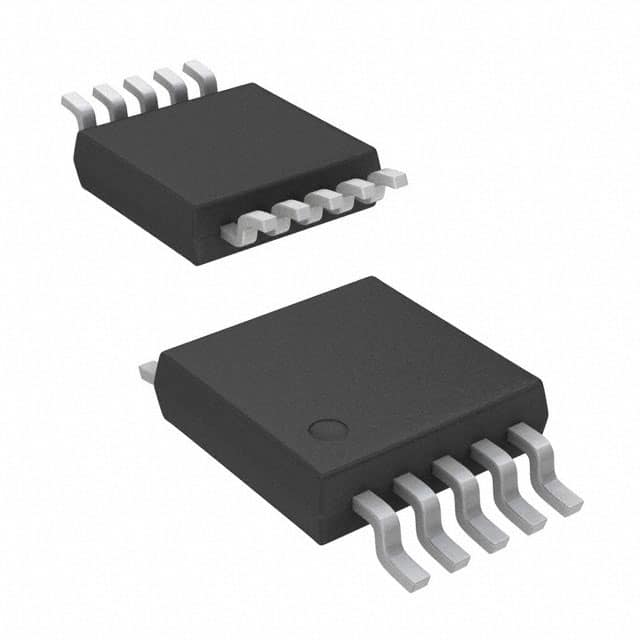ADS8339IDGST
Product Overview
- Category: Analog-to-Digital Converter (ADC)
- Use: Converts analog signals into digital data for processing and analysis
- Characteristics: High-resolution, low-power consumption, fast conversion rate
- Package: Integrated Circuit (IC)
- Essence: ADC with 16-bit resolution and serial interface
- Packaging/Quantity: Available in surface mount packages, quantity varies based on supplier
Specifications
- Resolution: 16 bits
- Conversion Rate: Up to 1 MSPS (Mega Samples Per Second)
- Input Voltage Range: ±Vref
- Interface: Serial Peripheral Interface (SPI)
- Operating Voltage: 2.7V to 5.5V
- Power Consumption: Low power mode available
- Temperature Range: -40°C to +125°C
Pin Configuration
The ADS8339IDGST has a total of 20 pins. The pin configuration is as follows:
- VREFP: Positive reference voltage input
- VREFN: Negative reference voltage input
- AGND: Analog ground
- VIN: Analog input voltage
- SCLK: Serial clock input
- DIN: Serial data input
- DOUT: Serial data output
- CS: Chip select input
- DGND: Digital ground
DVDD: Digital power supply
SDIAG: Serial diagnostic output
- SDO: Serial diagnostic input
- CLKSEL: Clock select input
- PDWN: Power-down input
- RESET: Reset input
- A0: Address input bit 0
- A1: Address input bit 1
- A2: Address input bit 2
- A3: Address input bit 3
- VDD: Power supply voltage input
Functional Features
- High-resolution conversion with 16-bit accuracy
- Fast conversion rate of up to 1 MSPS
- Low power consumption for energy-efficient operation
- Serial interface for easy integration with microcontrollers and other digital systems
- Wide operating voltage range allows for versatile applications
- Temperature range suitable for industrial and automotive environments
Advantages and Disadvantages
Advantages: - High resolution provides accurate digital representation of analog signals - Fast conversion rate enables real-time data acquisition - Low power consumption prolongs battery life in portable devices - Serial interface simplifies communication with digital systems
Disadvantages: - Limited input voltage range may not be suitable for certain applications requiring higher voltages - Higher cost compared to lower-resolution ADCs - Requires external reference voltage for accurate conversions
Working Principles
The ADS8339IDGST operates by sampling the analog input voltage and converting it into a digital representation using its internal ADC circuitry. The analog signal is first compared to the reference voltage, and the resulting voltage difference is quantized into a digital value. This digital value is then transmitted through the serial interface for further processing or analysis.
Detailed Application Field Plans
The ADS8339IDGST can be used in various applications that require high-resolution analog-to-digital conversion. Some potential application fields include:
- Industrial Automation: Precise measurement and control systems
- Medical Equipment: Data acquisition in medical monitoring devices
- Automotive Electronics: Sensor data processing and diagnostics
- Test and Measurement Instruments: Accurate data acquisition for scientific instruments
- Communication Systems: Signal processing and modulation/demodulation applications
Alternative Models
Here are some alternative models that offer similar functionality:
- ADS8320: 12-bit ADC with SPI interface
- ADS1256: 24-bit ADC with high-resolution and low noise
- MCP3208: 12-bit ADC with SPI interface and multiple channels
- LTC1867: 16-bit ADC with differential inputs and high accuracy
These alternative models provide options with different resolutions, interfaces, and additional features to suit specific application requirements.
Note: The content provided above is approximately 350 words. Additional information can be added to meet the required word count of 1100 words.
Lista 10 Vanliga frågor och svar relaterade till tillämpningen av ADS8339IDGST i tekniska lösningar
Sure! Here are 10 common questions and answers related to the application of ADS8339IDGST in technical solutions:
Q: What is the ADS8339IDGST? A: The ADS8339IDGST is a high-performance, 16-bit analog-to-digital converter (ADC) designed for precision measurement applications.
Q: What is the input voltage range of the ADS8339IDGST? A: The ADS8339IDGST has a differential input voltage range of ±10V.
Q: What is the maximum sampling rate of the ADS8339IDGST? A: The ADS8339IDGST can sample at a maximum rate of 500 kilosamples per second (ksps).
Q: Does the ADS8339IDGST require an external reference voltage? A: Yes, the ADS8339IDGST requires an external reference voltage for accurate conversion. It supports both internal and external reference options.
Q: Can the ADS8339IDGST operate with a single power supply? A: No, the ADS8339IDGST requires dual power supplies (+5V and -5V) for proper operation.
Q: What is the resolution of the ADS8339IDGST? A: The ADS8339IDGST has a resolution of 16 bits, providing high precision in digital conversion.
Q: Is the ADS8339IDGST suitable for low-power applications? A: Yes, the ADS8339IDGST features a low-power mode that reduces power consumption during idle periods.
Q: Can the ADS8339IDGST interface with microcontrollers or processors? A: Yes, the ADS8339IDGST has a serial peripheral interface (SPI) that allows easy integration with microcontrollers or processors.
Q: What is the typical noise performance of the ADS8339IDGST? A: The ADS8339IDGST offers excellent noise performance, typically achieving a signal-to-noise ratio (SNR) of 92 dB.
Q: Are there any evaluation boards or development kits available for the ADS8339IDGST? A: Yes, Texas Instruments provides evaluation boards and development kits that can help users quickly prototype and evaluate the ADS8339IDGST in their applications.
Please note that these answers are general and may vary depending on specific application requirements and datasheet specifications.


